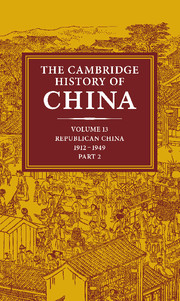Crossref Citations
This Book has been
cited by the following publications. This list is generated based on data provided by Crossref.
Fitzgerald, John
1990.
The Misconceived Revolution: State and Society in China's Nationalist Revolution, 1923–26.
The Journal of Asian Studies,
Vol. 49,
Issue. 2,
p.
323.
Yangwen, Zheng
2005.
The Social Life of Opium in China.
Langford, Christopher
2005.
Did the 1918–19 Influenza Pandemic Originate in China?.
Population and Development Review,
Vol. 31,
Issue. 3,
p.
473.
MacFarquhar, Roderick
2012.
Stuart Reynolds Schram, 1924–2012.
The China Quarterly,
Vol. 212,
Issue. ,
p.
1099.
Qi, Shouhua
2012.
Western Literature in China and the Translation of a Nation.
p.
87.
Bernardi, Andrea
and
Greenwood, Anna
2014.
Old and new Rural Co-operative Medical Scheme in China: the usefulness of a historical comparative perspective.
Asia Pacific Business Review,
Vol. 20,
Issue. 3,
p.
356.
Ho, Chun‐Yu
and
Li, Dan
2014.
A mirror of history: China's bond market, 1921–42.
The Economic History Review,
Vol. 67,
Issue. 2,
p.
409.
Xu, Lina
Cortese, Corinne
and
Zhang, Eagle
2014.
Ideology diffusion and the role of accounting: A Gramscian approach to understanding China’s transition from 1949 to 1957.
Accounting History,
Vol. 19,
Issue. 4,
p.
434.
Bernardi, Andrea
and
Miani, Mattia
2014.
The long march of Chinese co-operatives: towards market economy, participation and sustainable development.
Asia Pacific Business Review,
Vol. 20,
Issue. 3,
p.
330.
Li, Lifeng
2015.
Rural mobilization in the Chinese Communist Revolution: From the Anti-Japanese War to the Chinese Civil War.
Journal of Modern Chinese History,
Vol. 9,
Issue. 1,
p.
95.
Hu, Chao S.
Ferrari, Michel
Liu, Ru-De
Gao, Qin
and
Weare, Ethan
2016.
Mainland Chinese Implicit Theory of Wisdom: Generational and Cultural Differences.
The Journals of Gerontology Series B: Psychological Sciences and Social Sciences,
p.
gbw157.
Gong, Xun
and
Cortese, Corinne
2017.
A socialist market economy with Chinese characteristics: The accounting annual report of China Mobile.
Accounting Forum,
Vol. 41,
Issue. 3,
p.
206.
2017.
A Companion to Chinese History.
p.
378.
Pang, Qin
2019.
State-Society Relations and Confucian Revivalism in Contemporary China.
p.
55.
Zhang, Yi
2020.
Écriture et transmission des savoirs de l’Antiquité à nos jours.
Sui, Qing-yuan
2022.
Money and Government.
p.
29.
Zhang, Yaguang
Yu, Sitian
and
Zhang, Shengyi
2023.
The political economy of imperial power successions in ancient China.
Public Choice,
Vol. 197,
Issue. 1-2,
p.
137.
Cheng, Victor
2023.
China between Peace and War: Mao, Chiang and the Americans, 1945–1947.
Yu, Yichuan
2023.
Taxation in imperial China and the West.
Journal of Education, Humanities and Social Sciences,
Vol. 23,
Issue. ,
p.
819.
Luo, Xianmei
2024.
Art-oriented reconstruction movement and governance in rural China: illustrated by cases in Guangdong Province.
International Journal of Cultural Policy,
p.
1.



